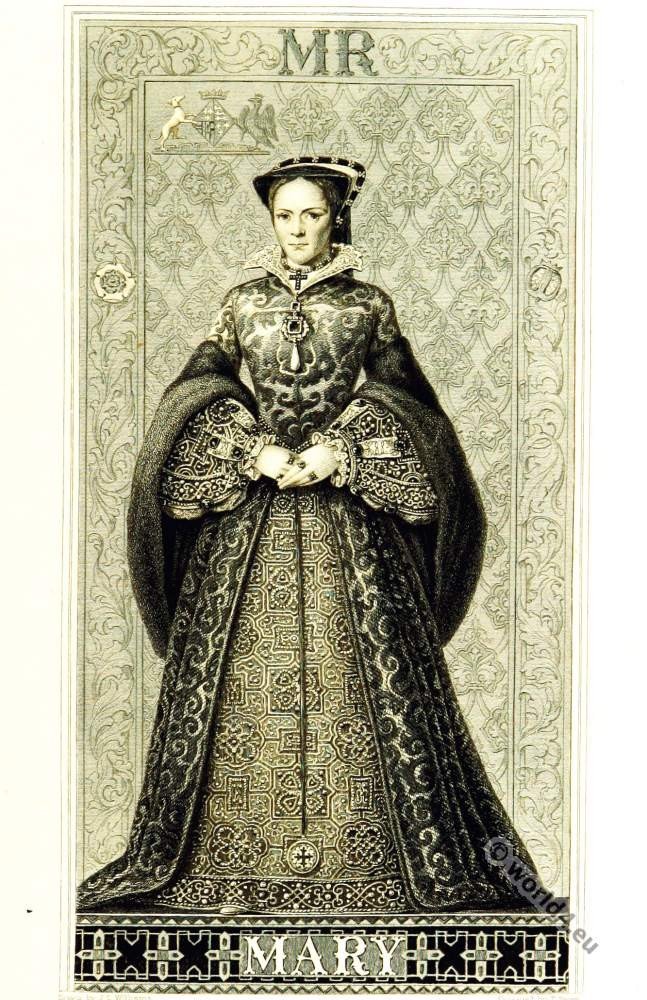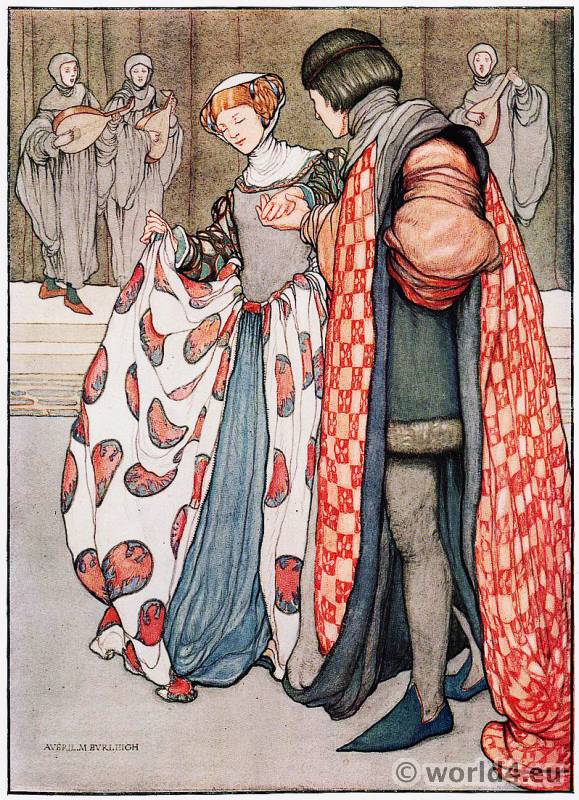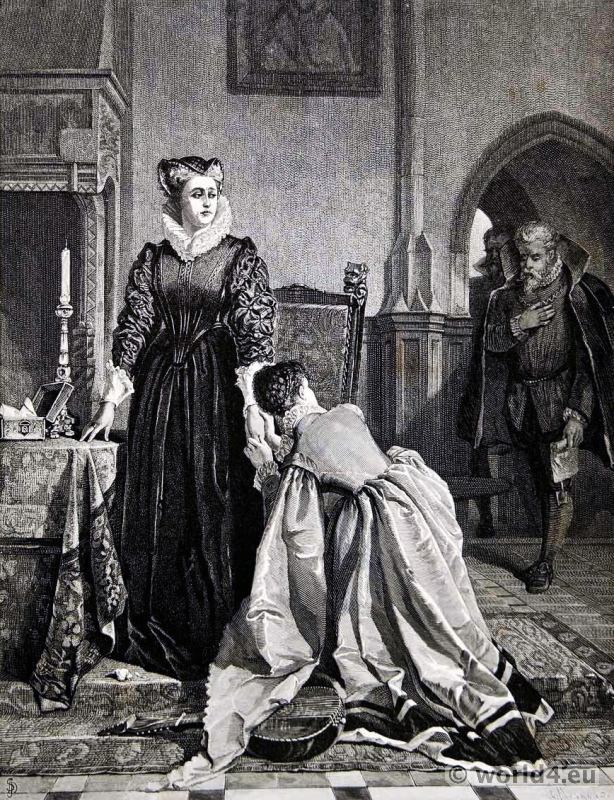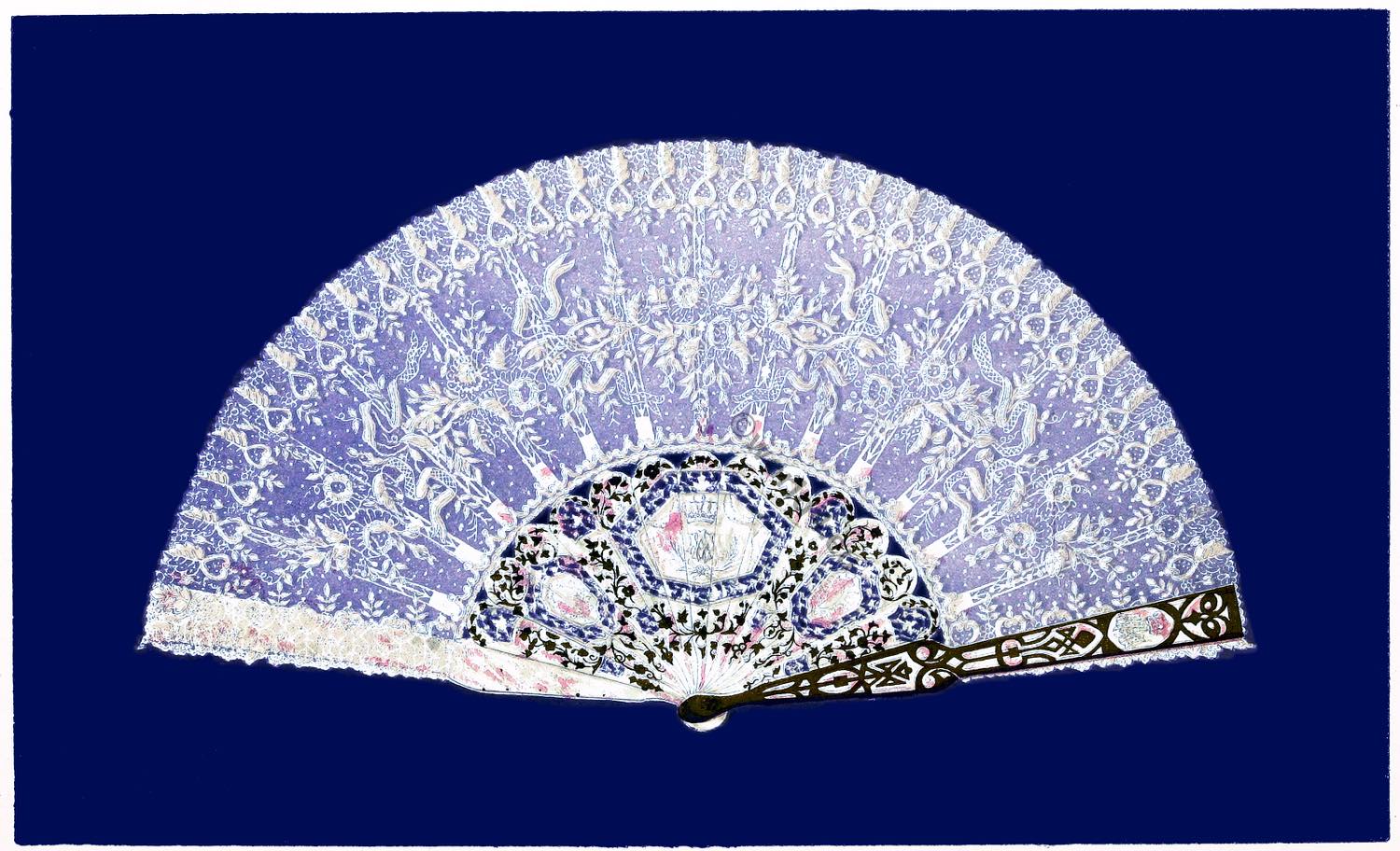Queen Mary, the daughter of Henry VIII.
Mary I, also Maria, the Catholic or the Bloody Mary (1516 – 1558), was from 1553 to 1558 Queen of England and Ireland and the fourth monarch of the Tudor House. She was the daughter of King Henry VIII. and his first wife, Catherine of Aragon. When her father had explained the marriage void and instead married Anne Boleyn, Mary was permanently separated from her mother, declared as royal bastard and excluded from the succession. Because of her refusal to Henry as head of the Church and to recognize itself as illegitimate, Mary fell into disgrace for years and escaped only by their ultimate subjugation of a conviction as a traitor. Henry took her again in 1544 in the succession to, but not legitimized her.
It is only in recent times that a fair examination of the facts of history, and a consideration of the conditions under which Mary succeeded to the throne, have led, if not to some vindication of her character, at all events to a very considerable mitigation of the dislike and aversion with which she has been regarded. It should be remembered that she was treated with injustice and suspicion from her birth, that she was denied the exercise of the religious observances which belonged to the faith in which she had been educated, that the persecutions with which her reign was disfigured were, to some degree, retaliations which followed the severities of Cranmer and others of the Protestant leaders against Romanism and heresy. Let us remember too that during the latter part of the short reign of Edward VI. various parts of the country were in partial insurrection,— that tyrannous laws and the oppressions of rulers who were trying to supplant each other, were nearly reproducing civil war, to which might have been added a still fiercer conflict, in the name of liberty of opinion on both sides, but with each side ready to persecute directly its adherents obtained the mastery.
It will be well in considering the history of this period, and of all periods where these religious questions are paramount, to note the fact that persecution to death is a logical deduction for any sect or “church” which, while it holds the belief that eternal salvation depends on the acceptance of certain dogmatic opinions, considers it a duty to enforce those opinions even to the death of the bodies of those who deny them, either for the possible salvation of the souls of the unbelievers themselves, by wringing from them a recantation, or in order to prevent the spread of a damning heresy. The remorseless disposition to persecute had been aroused long before, during the dark tempestuous close of Henry’s reign, and it seemed to rise to a fury of cruelty and a fanaticism of destruction under the influence of his elder daughter’s embittered temper, till men sickened and turned with loathing from the sight and scent of blood that pervaded the land.
But there formation of religion had been so surely advanced that the reaction in favor of Romanism was but a transient political symptom. Cranmer, whose character and conduct with regard to former friends and acknowledged foes we cannot regard with admiration, since it appears to have been actuated a tonce by too great subservience to his temporal superiors, and a too persistent and unscrupulous opposition to those who stood in the way of his policy, yet carried on the work of Protestantism with effect. He had seen Catharine of Aragon divorced, Anne Boleyn beheaded, Mary and Elizabeth declared to be illegitimate, and Edward placed on the throne.
During the short reign of the boy king, the work of the Reformation had been virtually accomplished. The visitation of dioceses was confirmed, and laymen were joined with bishops in ordering the points of religious belief and public worship; eminent preachers of there formed doctrines went the circuits with the visitors to expound the Scriptures, and a copy of the English Bible and of a translation of Erasmus’ paraphrase on the New Testament were ordered to be in every parish church in England. The parliament from which Bonner and Gardiner, the two most able and strenuous opponents of Cranmer, were excluded, began with repealing the atrocious acts which gave royal proclamations the force of law, and abrogated the additions to the law of treason and the laws against the Lollards. The new felonies created during the reign of Henry, and every other act concerning doctrine and matter of religion, were also dealt with in the first meeting of the parliament after the return of Somerset from Scotland. The form of administering the sacrament was changed, for it was ordered that the cup should be delivered to the laity as well as to the clergy. Thus with the prohibition of unlicensed preaching, the removal of shrines, the seizure of the plate and jewels belonging to them for the use of the king, and the clothes that covered them for the use of the poor, the forbidding of the elevation of the host, the order that the whole service of the church should be in the English language, the publication of a catechism by Cranmer for the profit and instruction of children and young people, and the meeting of a committee of divines for the composition of a new Liturgy, the Reformation proceeded.
That it was carried on with harshness and with persecutions is to be deplored, but it was an age of violence. True liberty of conscience was yet unknown, or at all events was disallowed. Though the amendments made by parliament seemed to be intended to set men free, new penalties and disabilities were pronounced against those who would not conform to the regulations. Punishments were less severe, the executions for opinions comparatively few, but a cold relentless temper characterized the proceedings of the council. The logical heartlessness which has been noticed as the result of the training of the young king seems to have characterized nearly all those who were in power.
Perhaps the act against mendicancy which was passed at that time was one of the most barbarous measures ever devised. Edward in his journal calls it an “extreme law,” and it cannot be doubted that it was to this that many of the insurrections in various parts of the kingdom were to be attributed. This act is very remarkable as the beginning of what may be called ” a poor law” in England. During the days before the Reformation it had been the practice for the various religious houses, as well as for some of the nobility of the country, to make provision for the relief of the poor, and in many places there was an open table in the baronial hall for necessitous wayfarers, and temporary food and shelter in the convents or the monasteries for those who were without either. Even at that time it was found necessary, in order to check these encouragements to mendicity, to proclaim laws against sturdy rogues and masterless men, and to threaten severe punishments against vagabonds and mendicants who were likely to become a serious danger to the community; but after the suppression of religious houses and the diminution of that feudal state which once distinguished the nobility, the danger was likely to assume alarming proportions. The parliament thought that the occasion demanded vigorous legislation, and the result was an act which, if it could have been carried out, would have established actual slavery in England. “The act for the punishment of vagabonds and the relief of poor and impotent persons” ordained that the latter, who included the maimed and the aged, who could not be styled vagabonds, should have houses provided for them, and be otherwise relieved in the places where they were born or had chiefly resided for the last three years, by the willing and charitable disposition of the parishioners. But the vast and appalling evil of mendicancy was to be met by desperate remedies. Any person found living idly or loiteringly for the space of three days, should, on being brought before a justice,be marked with a hot iron on the breast, and adjudged to be the slave for two years of the person informing against him, who “shall take the same slave, and give him bread, water or small drink, and refuse meat, and cause him to work by beating, chaining, or otherwise in such work and labour as he shall put him to, be it never so vile.” If this slave during the two years absented himself for fourteen days without leave he was to be branded on the forehead or the ball of the cheek, and condemned to be a slave to his said master for ever. If he ran away a second time, he was to suffer death as a felon. Masters could sell, bequeath, or let out for hire the services of their slaves, “after the like sort and manner as they may do of other their movable goods and chattels.” A master might put an iron ring about the neck, arm, or leg of his slave. Justices of the peace might inquire after idle persons, brand them and convey them to the places of their birth, there to be nourished and kept in chains or otherwise at the common works in amending highways, or in servitude to private persons; and all persons who chose to do so, could seize the children of beggars and retain them as apprentices, the boys till they were twenty four, the girls till they were twenty years of age. If they ran away during that time the master was permitted to recover them, to punish them with chains or otherwise, and to use them as slaves till their apprenticeship had expired.
These then were the provisions which, while they may be said to have been the original enactments which afterwards resulted in the organization of slavery abroad and of the poor law at home, were instrumental in keeping the country in a condition of revolt. To the reaction in favour of Romanism these harsh laws must greatly have contributed, and it was at the time when both were most active that the death of Edward left the throne vacant for the princess, who took to it a religion the rites of which she had been forbidden to observe, and a sense of years of wrong and injustice inflicted on her mother and herself.
Doubtless the repression to which Mary had so long been subject reacted in a kind of fanaticism, of which even her passionate regard for Philip of Spain was very largely composed. A considerable portion, if not the majority, of the country was in a state of recoil, or the unrelenting measures which were regarded for a time as necessary or inevitable reprisals could not have been suffered.
Darkness lowered over the whole kingdom, the lurid fires of persecution burned with a flame that threatened to destroy the sincerity and the honour of public men, who could see no safety but in recantation, if they were Protestants,or in acquiescence with a policy which was destroying England on behalf of Spain and the pope. Yet it was the very fury and recklessness of the queen and her Romish advisers against the reformed religion which at last extinguished the Papal domination in England. When Ridley and Latimer were burned at Oxford—those two sturdy old men—the latter turned round at the stake to say that they would that day light a candle in England which would not be put out, and he was right. Cranmer during months of imprisonment was constantly plied with devilish subtlety, for it was accompanied by temptations in the shape of pleasant changes from prison hardships and an implied promise that his life would be spared if he did but sign a recantation. He was nearly worn out, and seems to have been demoralized by the persistent wiles of his enemies, for he was not a courageous man, and had been often too much of a timeserver to Henry and to the ruling faction that succeeded him. He signed not one only but six recantations, and there is reason to believe that he was at once gnawed by remorse. Happily for him and for the nation his foes carried their duplicity to the end, and condemned him to die. The sentence awoke manhood and truth in his soul. The fallen primate, who had been cajoled into treachery, and who yielded to cowardice, reasserted his faith, condemned his own weakness, thrust into the flames the hand that had signed the recantations, and went cheerfully to be burned. It was practically all over with the Romish power then, though the queen, aided by the furious pope Paul IV., had by an unbridled exercise of bigotry, and with a temper rendered darker and more bitter by jealousy and disappointment, entered into a career which in less than five years gave her the title which has remained to this day,— the name of “Bloody Mary.”
Perhaps no better portrait of this unhappy and bigoted queen can be given than that of the Venetian Michele. These Venetian ambassadors appear to have been the most accomplished “word painters” of the time, and we are indebted to them for their graphic descriptions of our rulers. Michele writes:—”Queen Mary, the daughter of Henry VIII. and of his queen Catharine … is a princess of great worth. In her youth she was rendered unhappy by the events of her mother’s divorce, by the ignominy and threats to which she was exposed after the change of religion in England, she being unwilling to bend to the new one, and by the dangers to which she was exposed by the Duke of Northumberland and the riots among the people when she reached the throne. She is of short stature, thin and delicate, and moderately pretty; her eyes are so lively that she inspires reverence and respect and even fear whenever she turns them: nevertheless she is very short-sighted. Her voice is deep, almost like that of a man. She understands five languages, English, French, Spanish, Latin, and Italian, in which last, however, she does not venture to discourse. She is also much skilled in ladies’ work, such as producing all sorts of embroidery with the needle. She has a knowledge of music, chiefly on the lute, which she plays exceedingly well. As to the qualities of her mind, it may be said of her that she is rash, disdainful, and parsimonious rather than liberal. She is endowed with great humility and patience, but withal high-spirited, courageous, and resolute, having during the whole course of her adversity been guiltless of any the least approach to meanness of comportment; she is, moreover, devout and staunch in the defence of her religion.
“Some personal infirmities under which she labours are the causes to her of both public and private affliction. To remedy these recourse was had to frequent blood-letting, and this is the real cause of her paleness, and the general weakness of her frame. The cabals she has been exposed to, the evil disposition of the people towards her, the present poverty and the debt of the crown, and her passion for King Philip, from whom she is doomed to live separate, are so many other causes of the grief by which she is overwhelmed. She is, moreover, a prey to the hatred she bears to my lady Elizabeth, and which has its source in the recollection of the wrongs she experienced on account of her mother, and in the fact that all eyes and hearts are turned towards my lady Elizabeth, as successor to the throne.”
This was written a year before the death of Mary, and making allowance for the tendencies of the author is a moderately accurate portrait of the daughter of Catharine of Aragon.
From the book: Pictures and Royal Portraits illustrative of English and Scottish History by Thomas Archer. London 1878. Free ebook. Amazon.
Associated to:
- The character of Henry VIII. Tudor King of England.
- The reign of Elizabeth. The days of Queen Bess.
- Tudor Queen. The offer of the crown to Lady Jane Grey.
- Mary Queen of Scots at Lochleven Castle.
- Sir Francis Drake.
- The english boy king Edward VI.
- Relics associated with Queen Elisabeth.
- Pictures and Royal Portraits Illustrative of English and Scottish History:
Discover more from World4 Costume Culture History
Subscribe to get the latest posts sent to your email.







